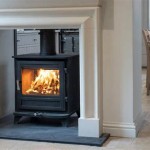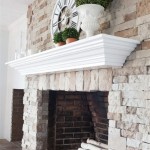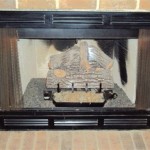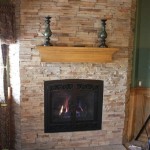Backyard Stone Fireplace Ideas: Enhancing Outdoor Living Spaces
A backyard stone fireplace provides a focal point for outdoor living spaces, offering both warmth and aesthetic appeal. These structures can significantly enhance the usability of patios and gardens, extending their functionality into cooler months. The selection of materials, design, and construction techniques is crucial for creating a safe, durable, and visually appealing fireplace.
Stone, a natural and versatile material, offers numerous options for backyard fireplace construction. The type of stone chosen significantly impacts the fireplace's appearance, durability, and overall cost. Careful consideration should be given to the local climate, desired aesthetic, and budget when selecting stone for a backyard fireplace project.
The installation of a stone fireplace typically requires professional expertise, ensuring adherence to local building codes and safety regulations. Proper foundation preparation, masonry techniques, and chimney construction are essential for a functional and safe fireplace.
Selecting the Right Stone for Your Backyard Fireplace
The choice of stone is a fundamental aspect of designing a backyard fireplace. Different types of stone offer varying characteristics in terms of color, texture, durability, and cost. Understanding these differences is essential for making an informed decision that aligns with the desired aesthetic and functional requirements.
Fieldstone, characterized by its irregular shapes and natural appearance, offers a rustic and organic aesthetic. Its varying sizes and textures contribute to a visually interesting fireplace design. Fieldstone is often locally sourced, potentially reducing material costs and environmental impact. However, the irregular shapes of fieldstone can present challenges during construction, requiring skilled masonry techniques to achieve a stable and aesthetically pleasing structure.
Flagstone, known for its large, flat slabs, provides a more contemporary and streamlined appearance. Its smooth surface and consistent thickness make it easier to work with, resulting in a more uniform fireplace design. Flagstone is available in a variety of colors and textures, offering flexibility in achieving different aesthetic styles. However, flagstone may be more expensive than fieldstone, depending on the specific type and availability.
Ledgestone, characterized by its thin, stacked appearance, provides a textured and visually striking fireplace design. Its modular nature makes it relatively easy to install, reducing labor costs. Ledgestone is available in both natural and manufactured options, offering a wide range of colors and styles. Manufactured ledgestone provides a consistent look and may be more affordable than natural ledgestone, but it may lack the unique character and durability of natural stone.
Brick, while not strictly stone, is often used in conjunction with stone to create visually appealing and durable fireplaces. Brick offers a classic and timeless aesthetic, and its uniform size and shape make it easy to work with. Brick is also fire-resistant and relatively low-maintenance. Combining brick with stone elements, such as a stone hearth or chimney, can create a visually interesting and structurally sound fireplace.
When selecting stone, it is crucial to consider its resistance to weathering and temperature fluctuations. Certain types of stone may be more susceptible to cracking or crumbling in harsh climates. Consulting with a professional mason can help determine the best type of stone for a specific geographic location and environmental conditions.
Designing Your Backyard Stone Fireplace: Style and Functionality
The design of a backyard stone fireplace should consider both aesthetic appeal and functional requirements. The size, shape, and features of the fireplace should be tailored to the specific needs and preferences of the homeowner, as well as the overall design of the outdoor living space.
A freestanding fireplace provides a focal point in the backyard, offering 360-degree visibility and radiating heat in all directions. Freestanding fireplaces are typically larger and more elaborate than other types of fireplaces, requiring a significant amount of space. These fireplaces can be designed with features such as built-in seating, storage for firewood, and cooking grates.
A corner fireplace is a space-saving option that fits neatly into a corner of a patio or garden. Corner fireplaces are ideal for smaller outdoor spaces where maximizing space is a priority. These fireplaces can be designed with a rustic or contemporary aesthetic, depending on the choice of stone and design details.
An outdoor fireplace integrated into a retaining wall or outdoor kitchen creates a cohesive and functional outdoor living space. Integrating the fireplace into existing structures maximizes space and creates a seamless transition between different elements of the outdoor design. This type of fireplace is often designed with built-in countertops, storage, and grilling areas.
The height and width of the fireplace opening should be carefully considered to ensure proper draft and heat radiation. A taller chimney will generally provide a better draft, preventing smoke from billowing into the surrounding area. The width of the opening should be proportional to the overall size of the fireplace, creating a balanced and visually appealing design.
Features such as a built-in wood storage niche, overhead mantel, or integrated seating can enhance the functionality and aesthetic appeal of the fireplace. A wood storage niche provides a convenient place to store firewood, keeping it dry and readily accessible. An overhead mantel adds a decorative element and provides a place to display outdoor accessories. Integrated seating creates a comfortable and inviting space for relaxing and enjoying the warmth of the fire.
The inclusion of cooking grates or a pizza oven transforms the fireplace into a versatile outdoor cooking appliance. Cooking grates allow for grilling food over an open flame, while a pizza oven provides a dedicated space for baking pizzas and other baked goods. These features can significantly enhance the functionality and enjoyment of the backyard fireplace.
Ensuring Safety and Compliance in Backyard Stone Fireplace Construction
Safety is the paramount concern when constructing a backyard stone fireplace. Adherence to local building codes and safety regulations is essential for preventing fires and ensuring the structural integrity of the fireplace. Professional installation is highly recommended, as experienced masons possess the knowledge and skills necessary to build a safe and functional fireplace.
Proper foundation preparation is crucial for ensuring the stability and longevity of the fireplace. A solid and level foundation prevents the fireplace from settling or shifting over time, which can lead to cracks and structural damage. The foundation should be constructed from concrete or a similar material that can withstand the weight of the stone fireplace.
The chimney is a critical component of the fireplace, responsible for venting smoke and gases away from the surrounding area. The chimney should be constructed of fire-resistant materials, such as brick or stainless steel, and should extend high enough to ensure proper draft. The chimney should also be equipped with a spark arrestor to prevent embers from escaping and potentially starting a fire.
The firebox, the area where the fire is built, should be constructed of firebrick or another fire-resistant material. Firebrick is designed to withstand the high temperatures of a wood-burning fire, preventing the surrounding stonework from becoming damaged. Mortar used in the firebox should also be fire-resistant, ensuring a durable and long-lasting structure.
Maintaining a safe distance between the fireplace and any combustible materials, such as wood fences, trees, or patio furniture, is essential for preventing fires. Local building codes typically specify minimum clearance distances for fireplaces. These distances should be strictly observed to ensure the safety of the surrounding area.
Regular maintenance is essential for keeping the fireplace in good working condition. The chimney should be inspected and cleaned regularly to remove creosote buildup, which can pose a fire hazard. Any cracks or damage to the stonework should be repaired promptly to prevent further deterioration. Following these maintenance procedures will help ensure the safety and longevity of the backyard stone fireplace.
Obtaining the necessary permits and approvals from local authorities is crucial before beginning any construction project. Building codes and regulations vary from jurisdiction to jurisdiction, and it is important to ensure that the fireplace design and construction comply with all applicable requirements. Failure to obtain the necessary permits can result in fines and delays, or even the need to dismantle the fireplace.
By carefully considering these factors and working with qualified professionals, homeowners can create a backyard stone fireplace that enhances their outdoor living space, provides warmth and comfort, and ensures the safety of their property. The enduring appeal of a stone fireplace makes it a worthwhile investment for enhancing the enjoyment of outdoor spaces for years to come.

Five Fabulous Outdoor Fireplace Ideas Coogans Landscape Design

30 Outdoor Fireplace Ideas Cozy Fireplaces

Outdoor Fireplace Ideas Inspiration Dutchies Stoneworks

Amazing Fire Pit Outdoor Fireplace Ideas Natural Brick Stone Depot

Outdoor Fireplace Trends Environmental Designs

Natural Stacked Stone Veneer Fireplace Ideas

25 Stone Fireplace Ideas For A Cozy Nature Inspired Home Chimeneas Diseño De Chimenea Cocina Al Aire Libre

Natural Stone Outdoor Fireplace Ideas Photos Houzz

How To Build An Outdoor Stacked Stone Fireplace

Tag Archive For Outdoor Fireplace Ideas Landscaping Company Pa Custom Pools Walkways Patios Fence Companies Decks








